Search
The web client application includes a Search page that can be accessed from the blue Action bar.
Since version 20.8.0 by default the Search page will return no search results. You need to add the search criteria in order to have the registered items displayed.
{info} You can just hit the Search button even without setting search criteria, but note that the search response might take even several minutes.
 |
|---|
| Search page |
Search enables locating entries already stored in the registry database using a set of filtering options. For example, a very general search can be chosen that scans the entire database, or a very specific one using the combination of the available filters. The search service also supports the use of chemical structures as queries.
On the Search page currently only the search for registered compounds is available (search for the salts and/or solvates from the DB is not possible).
Since version 20.19.0 field identifiers are displayed either next to field labels or as a tooltip when hovering over the respective field label in all relevant places on the search page.
Field identifiers are shown in a tooltip on the Search page above the column names (labels).
 |
|---|
| Search page header with id tooltip |
Ids are also displayed as tooltip while configuring new columns.
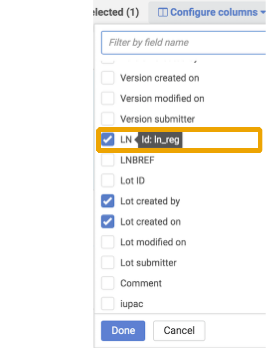 |
|---|
| Configure columns - id tooltip |
Bulk edit data, and search criteria definition dropdowns show the field identifier alongside with the label.
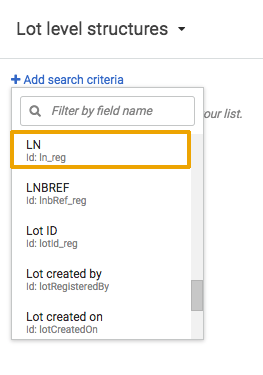 |
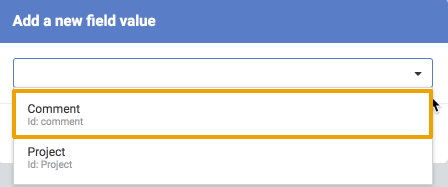 |
|---|---|
| Search criteria - labels and ids | Bulk edit - labels and ids |
The Search page is divided in two sections: search conditions (left side of the page) and search results (right side of the page):
Search conditions
The search conditions located on the left side of the Search page consist of:
-
Search for option
Compounds can be searched on parent, version or lot level.
-
Structure type
Two main types of search can be distinguished: simple and Markush search (the default is the simple search).
From version 20.8.0 it is also possible to search Deleted compounds . You can do this with the help of the toggles on the left hand side.
Search for existing normal compounds: Turn Off Markush search and Deleted search toggles.
Search for existing Markush structures: Turn On Markush search and turn Off Deleted search toggles.
Search for deleted normal compounds: Turn Off Markush search and turn On Deleted search toggles.
Search for deleted Markush structures: Turn On Markush search and Deleted search toggles.
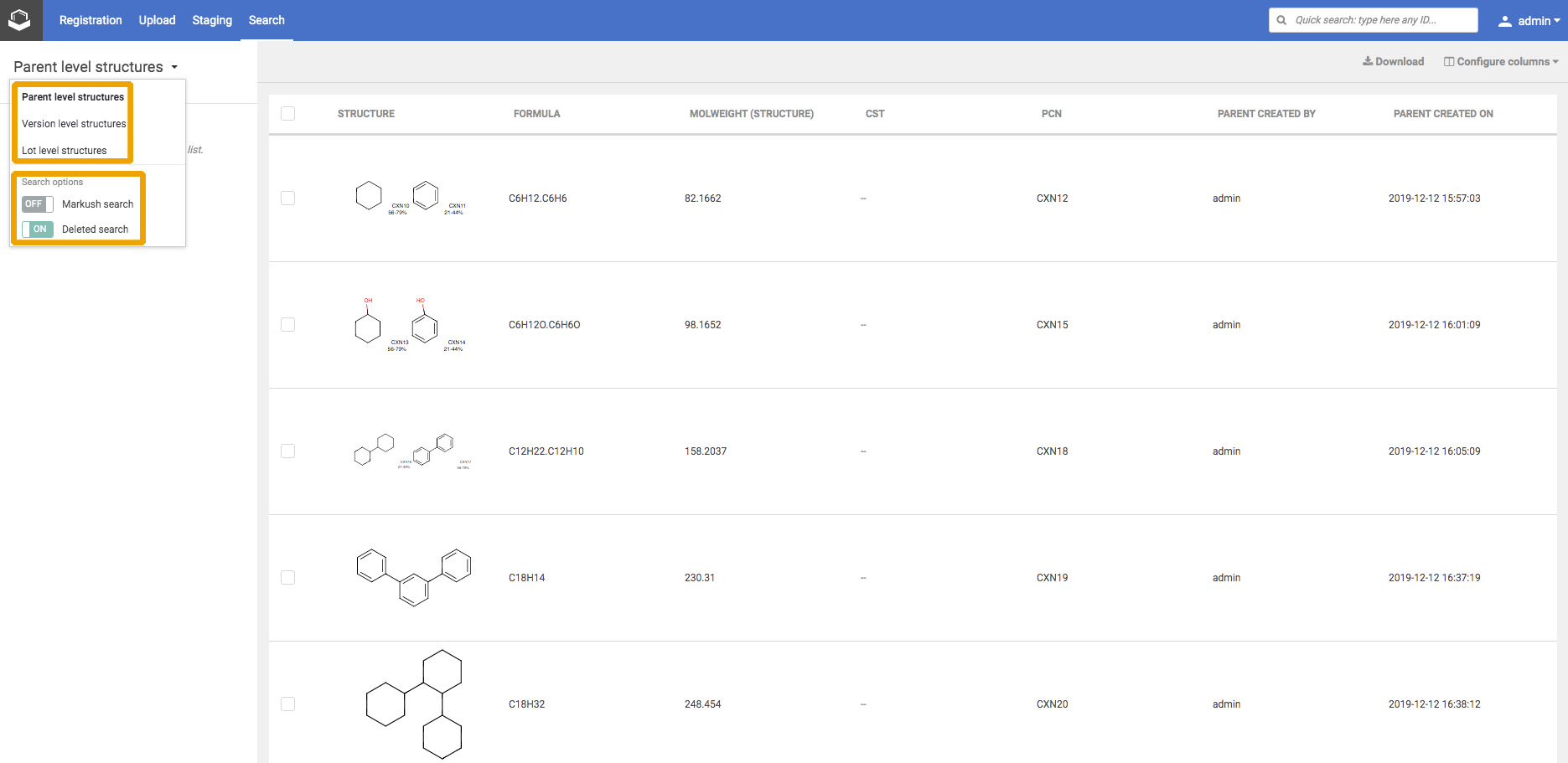
Search options -
Search criteria
The search criteria can be selected from a drop-down list. The list of search criteria is populated based on the previously set "search for" option. E.g. if "parent level" is set, the available search criterias are: Project, Structure, Structure name, Formula, Molweight (Structure), Structure type, Parent submitter, Parent created by, Parent created on, Molweight (Parent), Stereochemistry, Geometry isomerism, PCN, CST, Restricted. For version level more structure criteria are available, beside the ones for parent level, Version submitter, Version created by, Version created on, CN, Molweight (Version), Molweight (Version+Salt), Version fingerprint are available.
Search option are to be selected if the specified search conditions contain structural criteria.
{info} Currently, Structure type is among search criteria, but numbers should be provided in order to search for a given structure type.
The list of numbers for each structure type:
0: Single Structure
1: Mixture
2: Formulation
3: "ISOMER #"
4: Markush (Markush search should be enabled)
5: Alternate
6: Polymer
Search results
As a result of a search, a search table will be populated, where only the first 50 lines are visible. At each scroll 50 more hits will become available from the bottom of the page.
The table contains different columns depending on which level of the tree (parent, version or lot) is selected for search. E.g. for parent level results: Structure, Formula, Molweight (Structure), Parent created by, Parent created on, PCN, CST; for lot level structures: Structure, Formula, CST, Version created by, Version created on, CN, Molweight (Structure+Salt), Lot created by, Lot created on, LN columns are the default setting. The visible columns can be easily configured by pressing the [Configure columns] button located on the top right side above the search result table. After selecting the appropriate check-boxes in the column configuration list, in case of newly added columns, a "Missing data in new columns" message will appear next to the [Configure columns] button. To populate the search table with the selected columns, please press the [Refresh] button located next to the [Configure columns].
When clicking on the structure, a structure preview containing the fused image will be opened.
Each result can be opened on the Details page, if the blue link icon next to the structure is pressed (except deleted records).
Search results can be downloaded to an SD file. For more details consult the Download chapter.
Bulk edit of additional data
From version 20.8.0-2005111440 with the appropriate role it is possible to edit (add, replace or delete) additional data of several compounds simultaneously. This feature can be found on Search page after you select one or more compounds. You can edit one field at once. These changes will be visible in the compound's history.
Only non-identifying attributes can be edited. The followings cannot be modified:
-
Structure
-
CST
-
Read only fields
-
System fields
 |
|---|
| Bulk edit additional data |
Bulk add additional data:
You can use this function to add a value to additional data fields. Both List and non-list additional data are supported, but you can only add to non-list additional data if it is empty, otherwise it is omitted.
 |
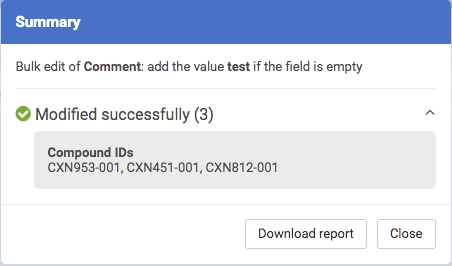 |
|---|---|
| 1. Bulk add a new field value | 2. Summary after bulk add a new value |
After you choose a field you should enter a new value. When you click to 'Add value to all' then this value will be added to all of the selected compounds. At the end of the process you will see a summary page. Here you can see the numbers and the IDs of the modified compounds. There are 3 categories:
-
Modified successfully: The new value has been added successfully.
-
Skipped: The field was not empty (when multi-values are not allowed in the field config).
-
Error occurred: e.g there is a validation rule for the given field. If the field should be e.g unique and you try to add a not unique value.
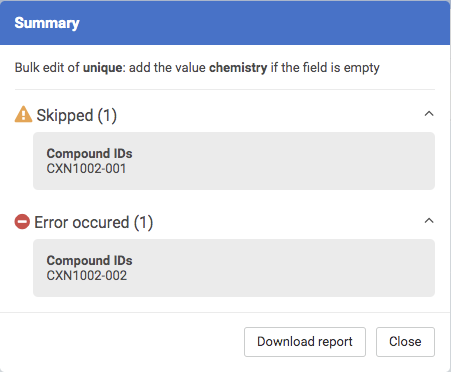
Categories for not successful 'bulk add'
By clicking the 'Download report' button you can get a file which contains the compound IDs in every category (Successful, Skipped, Error occurred).
Bulk replace additional data
You can use this function to replace an existing additional data e.g correct a typo. You cannot replace an empty value, you can add a value with the help of 'bulk add' function. It is also not possible to replace an existing value to an empty one, you can do this with the help of 'bulk delete' function.
 |
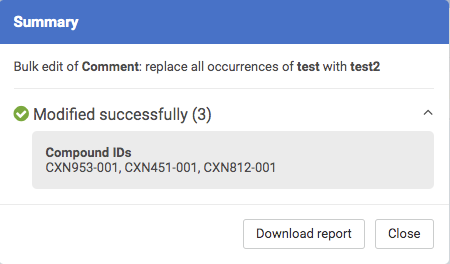 |
|---|---|
| 1. Bulk replace field value | 2. Summary after bulk replace a field value |
After you choose a field you should choose the original value and enter a new value. When you click to 'Replace all occurrences' then the original value will be replace for all compounds. At the end of the process you will see a summary page. Here you can see the numbers and the IDs of the modified compounds. There are 3 categories:
-
Modified successfully: The value has been replaced successfully.
-
Skipped: Some of the chosen compounds do not have the value that should be replaced.
-
Error occurred: e.g there is a validation rule for the given field. If the field should be e.g unique and you try to replace to a not unique value.
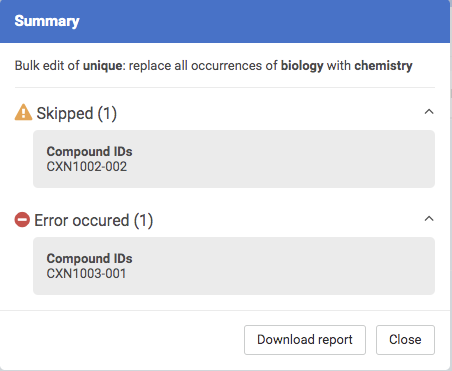
Categories for not successful 'bulk replace' By clicking the 'Download report' button you can get a file which contains the compound IDs in every category (Successful, Skipped, Error occurred).
Bulk delete additional data
You can use this function to delete an existing additional data.
 |
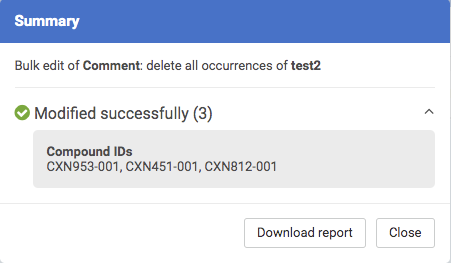 |
|---|---|
| 1. Bulk delete a field value | 2. Summary after bulk delete a field value |
After you choose a field you should choose the value you would like to delete. When you click to 'Delete all occurrences' then this value will be deleted from all of the selected compounds. At the end of the process you will see a summary page. Here you can see the numbers and the IDs of the modified compounds. There are 3 categories:
-
Modified successfully: The value has been deleted successfully.
-
Skipped: Some of the chosen compounds do not have the value that should be deleted.
-
Error occurred: e.g there is a validation rule for the given field. If the field is e.g required and you try to delete.
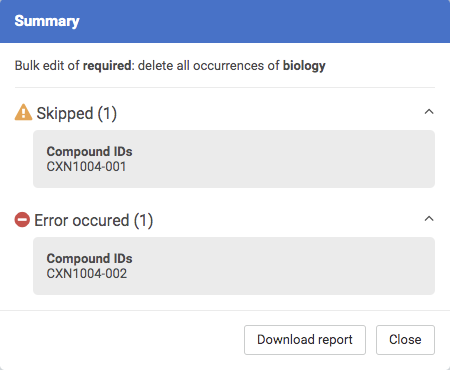
Categories for not successful 'bulk delete' By clicking the 'Download report' button you can get a file which contains the compound IDs in every category (Successful, Skipped, Error occurred).